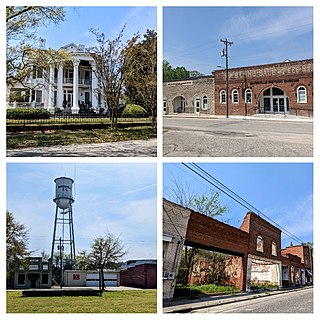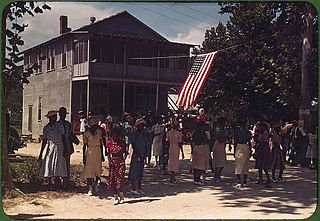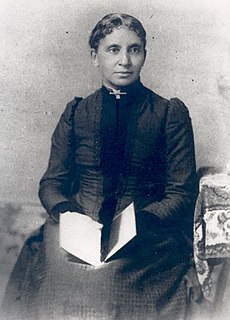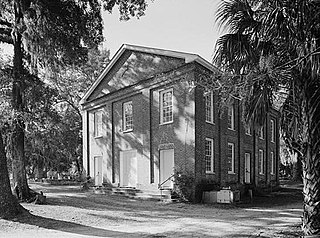Related Research Articles

Mayesville is a town in Sumter County, South Carolina, United States. The population was 731 at the 2010 census, this was a decline from 1,001 in 2000. It is included in the Sumter, South Carolina Metropolitan Statistical Area.
Orange Grove may refer to:

St. Helena Island is a Sea Island in Beaufort County, South Carolina, United States. The island is connected to Beaufort by U.S. Highway 21. The island has a land area of about 64 sq mi (170 km2) and a population of 8,763 as of the 2010 census. It is included as part of the Hilton Head Island-Beaufort Micropolitan Area. The island is renowned for its rural Lowcountry character and being a major center of African-American Gullah culture and language. It is considered to be the geographic influence behind the children's television program Gullah Gullah Island.

Charlotte Louise Bridges Forten Grimké was an African American anti-slavery activist, poet, and educator. She grew up in a prominent abolitionist family in Philadelphia. She taught school for years, including during the Civil War, to freedmen in South Carolina. Later in life she married Francis James Grimké, a Presbyterian minister who led a major church in Washington, DC, for decades. He was a nephew of the abolitionist Grimké sisters and was active in civil rights.

Edmund Ruffin III was a wealthy Virginia planter who served in the Virginia Senate from 1823 to 1827. In the last three decades before the American Civil War, his pro-slavery writings received more attention than his agricultural work. Ruffin, a slaveholder, staunchly advocated states' rights and slavery, arguing for secession years before the Civil War, and became a political activist with the so-called Fire-Eaters. Ruffin is given credit for "firing the first shot of the war" at the Battle of Fort Sumter in April 1861 and fought as a Confederate soldier despite his advanced age. When the war ended in Southern defeat in 1865, he committed suicide rather than submit to "Yankee rule."

Mary Boykin Chesnut was an American author noted for a book published as her Civil War diary, a "vivid picture of a society in the throes of its life-and-death struggle." She described the war from within her upper-class circles of Southern slaveowner society, but encompassed all classes in her book. She was married to a lawyer who served as a United States senator and Confederate officer. Chesnut worked toward a final form of her book in 1881–1884, based on her extensive diary written during the war years. It was published in 1905, 19 years after her death. New versions were published after her papers were discovered, in 1949 by the novelist Ben Ames Williams, and in 1981 by the historian C. Vann Woodward, whose annotated edition of the diary, Mary Chesnut's Civil War (1981), won the Pulitzer Prize for History in 1982. Literary critics have praised Chesnut's diary—the influential writer Edmund Wilson termed it "a work of art" and a "masterpiece" of the genre—as the most important work by a Confederate author.

James Chesnut Jr. was an American lawyer and politician, and a Confederate functionary.

Alice Dayrell Caldeira Brant was a Brazilian juvenile writer. When she was a teenager, she kept a diary, which describes life in Diamantina, Minas Gerais, Brazil which was then published in 1942. The diary was published under a pen name Helena Morley. When it was originally published it was in portuguese under the title Minha Vida de Menina. The diary was then translated in to English by Elizabeth Bishop in 1957.

Laura Matilda Towne was an American abolitionist and educator. She is best known for forming the first freedmen's schools, notably the Penn School.

The Old Campus District, University of South Carolina, is a historic district centered on The Horseshoe on the main campus of the University of South Carolina in Columbia, South Carolina. On June 5, 1970, it was listed in the National Register of Historic Places. On April 19, 1996 MTV Unplugged filmed Hootie & the Blowfish's concert on The Horseshoe before the release of their second album Fairweather Johnson.
James McBride Dabbs Jr. (1937–2004) was a social psychologist and professor of psychology at Georgia State University. Born in 1937 in Sumter, South Carolina, he obtained his doctorate from Yale in 1962. In 2004, he died from cancer.

The Penn Center, formerly the Penn School, is an African-American cultural and educational center in the Corners Community, on Saint Helena Island. Founded in 1862 by Quaker and Unitarian missionaries from Pennsylvania, it was the first school founded in the Southern United States specifically for the education of African-Americans. It provided critical educational facilities to Gullah slaves freed after plantation owners fled the island, and continues to fulfill an educational mission. Leigh Richmond Miner photographed students and activities at the school.

Ladys Island is a predominantly residential Sea Island located in Beaufort County, South Carolina. Small portions of the island are within the City of Beaufort, while the majority of the island remains unincorporated. The South Carolina Highway 802, also known locally as Sams Point Road, serves as the principal highway for Ladys Island and provides the only access to Coosaw Island.

The Frogmore Plantation Complex, located on Saint Helena Island, in Beaufort County, South Carolina, is significant for several reasons. First, the plantation home, along with its contributing properties, offers an excellent example of the area's architectural development from 1790–1920. Second, the plantation's long association with prominent families contributes to its significance. The plantation was first owned by Lieutenant Governor William Bull, who then willed it to his son in 1750.

Rip Raps Plantation, also known as the James McBride Dabbs House, is a historic plantation house and national historic district located near Sumter, Sumter County, South Carolina. It was the home of James McBride Dabbs, author and leading advocate for social justice and civil rights (1896-1970).
Ruth Currie-McDaniel, formerly Ruth Douglas Currie, is a professor and historian of Reconstruction Era history in the United States. She attended Warren Wilson College in Swannanoa, North Carolina. She is professor emerita at Appalachian State University's history department and was a historian for the U.S. Army Strategic Defense Command for four years. She retired as professor of history and political science at Warren Wilson College in Asheville, North Carolina. She has written books about John Emory Bryant, his wife Emma Spaulding Bryant, and American policy in the Pacific theater including Kwajalein Atoll and the Marshall Islands.

James McBride Dabbs was an American author and farmer from South Carolina known for his writings on religion and Southern culture. He has been recognized as one of the South's leading liberals during his time. Dabbs was cited in Martin Luther King Jr.'s Letter from Birmingham Jail as a Southern writer who wrote about the struggle of African Americans in "eloquent and prophetic terms." He has also been called the only native Southern critic during the civil rights movement who saw "more good than ill in the Southern tradition."
Louisa Wells Aikman, also known as Louisa Susannah Aikman, was a British author and music score collector. She is best known for her book, The journal of a voyage from Charleston, S.C., to London.

Leigh Richmond Miner (1864–1935) was a photographer in the United States.
References
- ↑ "Everything Happens at the Crossroads: James McBride Dabbs – the second son". Everything Happens at the Crossroads. Retrieved 2019-04-30.
- ↑ "Oral History Interview with Edith Mitchell Dabbs, October 4, 1975. Interview G-0022. Southern Oral History Program Collection (#4007): Electronic Edition. A Southern Woman Advocates Social and Racial Justice in South Carolina in the Mid-Twentieth Century". 2019-02-11. Archived from the original on 2019-02-11. Retrieved 2019-04-30.
- ↑ "Dabbs, Edith Mitchell". South Carolina Encyclopedia. Retrieved 2019-04-30.
- ↑ "Dabbs, James McBride, 1896–1970 @ SNAC". snaccooperative.org. Retrieved 2019-04-30.
- ↑ Dabbs, Edith (2018). "Edith Mitchell Dabbs Papers" (PDF). Edith Mitchell Dabbs Papers. Retrieved May 11, 2019.
- ↑ Jones-Branch, Cherisse. Crossing the Line : Women’s Interracial Activism in South Carolina During and After World War II. University Press of Florida, 2014. p. 80-89.
- ↑ Harvey, Paul (2005). Freedom's Coming. Chapel Hill, NC: The University of North Carolina Press. p. 200. doi:10.5149/uncp/9780807829011. ISBN 9780807829011.
- ↑ Coleman, A. D. (1971-07-04). "Photography". The New York Times. ISSN 0362-4331 . Retrieved 2019-05-11.
- ↑ Twining, Mary Arnold (1972). "Reviewed Work: Face of an Island: Leigh Richmond Miner's Photographs of St. Helena Island by Edith M. Dabbs". The Journal of American Folklore. 85 (336): 199–200. doi:10.2307/539258. JSTOR 539258.
- ↑ Howland, Lawrence (1983). "Reviewed Work: Sea Island Diary: A History of St. Helena Island by Edith M. Dabbs". The South Carolina Historical Magazine. 85 (2): 160–161 – via JSTOR.
- ↑ Clifton, James (April 1984). "Reviewed Work: Sea Island Diary: A History of St. Helena Island by Edith M. Dabbs". The North Carolina Historical Review. 61 (2): 259–260 – via JSTOR.
- ↑ Alexander, Roberta Sue (1984). "Reviewed Work: Sea Island Diary: A History of St. Helena Island. by Edith M. Dabbs". The Journal of Southern History. 50 (4): 676. doi:10.2307/2208513. JSTOR 2208513.
- ↑ "Dabbs, Edith Mitchell". South Carolina Encyclopedia. Retrieved 2019-04-30.
- ↑ "Rip Raps Plantation – Sumter County, South Carolina SC". south-carolina-plantations.com. Retrieved 2019-04-30.